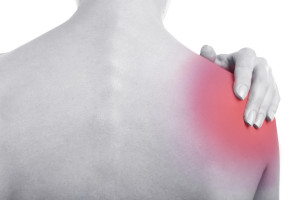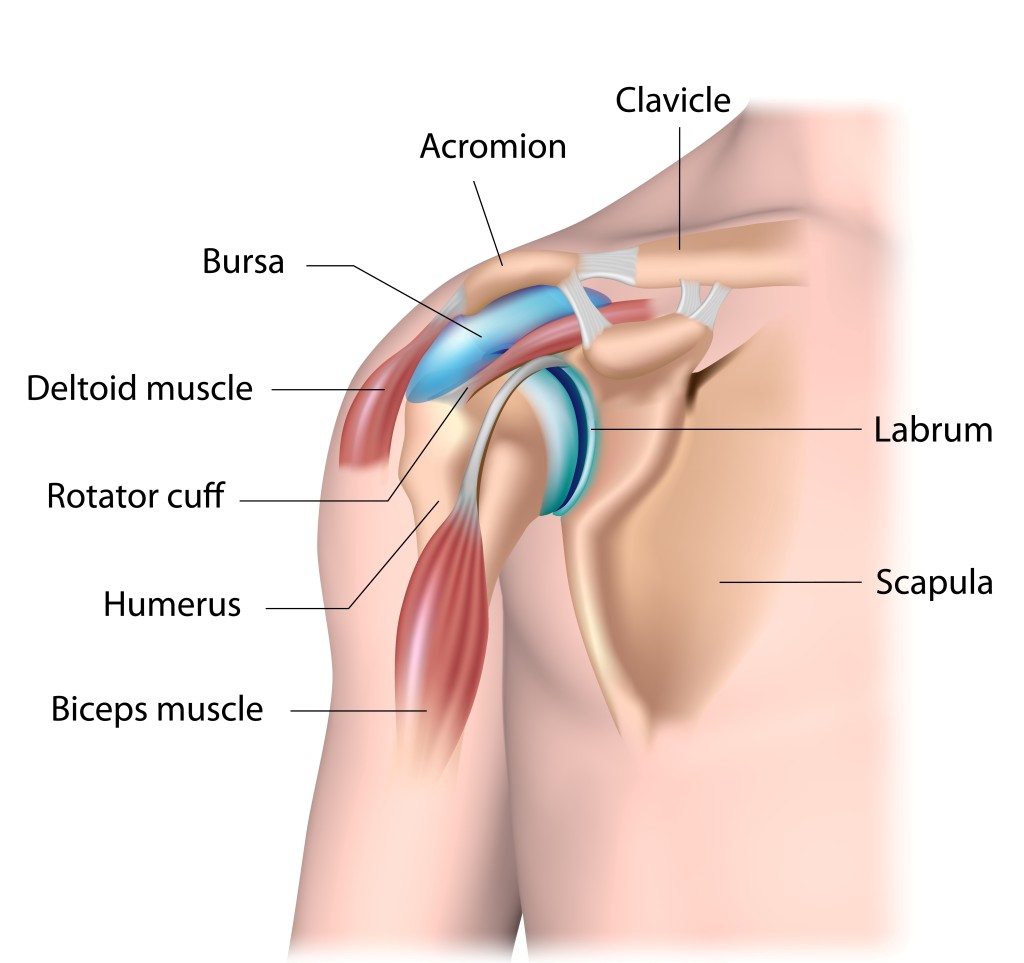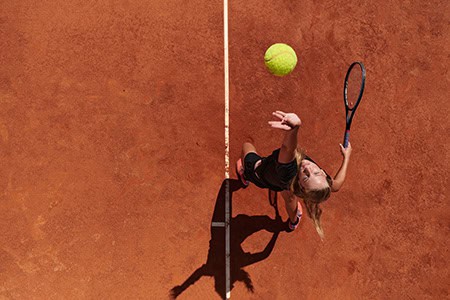Labral tear treatment in Burr Ridge
Also serving Plainfield, Morris and surrounding areas
| Procedure | • Arthroscopic, Outpatient • The torn labrum is sutured back into its normal position using the scope. |
| Duration | 1.5 hours–2 hours |
| Anesthesia | General |
| Recovery | • 3–5 months • Immediate physical therapy post-surgery • Return to work depends on the type of work • Return to sports is generally 4–6 months |
The labrum of the shoulder is a bumper of cartilage that surrounds the socket similar to the bumper around a pool table. This labrum stabilizes the ball into the socket. When torn, it is painful and may cause clicking or popping, as well as deep-seated pain in the shoulder. This may also cause the shoulder to feel loose.

Injury to the labrum generally involves overhand movement whether in the setting of acute injury or repetitive use of the shoulder. Lifting or jerking injuries to the shoulder are also common causes for a torn labrum. Overhand throwers or hitters such as volleyball, baseball, and softball are among the most susceptible to labral tears, especially SLAP tears in the shoulder.
The most common athletic activities that lead to labral tears are baseball, softball, volleyball, swimming, tennis, and football. The most common work injuries involve repetitive overhead lifting and pulling. They are also commonly caused by falls, or jerking type of injuries at work.

Types of Labral Tear
SLAP
This is an acronym that stands for Superior Labrum Anterior Posterior. Generally, this means that the cartilage bumper around the socket has torn in the upper portion of the socket. This is seen commonly with throwing injuries, lifting injuries, and injuries that cause a downward jerking motion to the shoulder.
Bankart Tear
This is a tear of the bumper of cartilage at the front of the socket and is usually caused by a shoulder joint dislocation or partial dislocation. Patients will have pain and a feeling of instability or looseness to the shoulder. Some patients may even have repeated episodes of a dislocating shoulder.
Labral Tear Treatment & Recovery
Both of the above may initially be treated with physical therapy and many patients will improve with this treatment alone. For patients who do not improve, Arthroscopic Repair of the torn labrum is the preferred method of treatment. This is an outpatient procedure, and recovery and rehabilitation will take 3–5 months.
Labral Tear FAQs
What are the symptoms of a shoulder labral tear?
The symptoms of a shoulder labral tear may include:
- Pain: Typically felt deep within the shoulder or in the back of the joint.
- Clicking or Popping Sensations: Patients might notice a clicking or popping sound when moving the shoulder.
- Decreased Range of Motion: There may be a reduction in how far or easily the shoulder can move.
- Weakness: The shoulder might feel weaker, impacting the ability to lift objects or perform tasks.
What are the common causes of a shoulder labral tear?
Shoulder labral tears can be caused by various factors:
- Trauma: Falls, direct blows to the shoulder, or sudden pulling movements can lead to tears.
- Overuse: Repetitive shoulder motions, especially in athletes like baseball pitchers or swimmers, can wear down the labrum.
- Degenerative Changes: Aging can lead to wear and tear of the labrum as the tissues become more brittle.
How common are shoulder labral tears?
- Shoulder labral tears are not uncommon and occur in specific groups:
- Prevalence: Frequently diagnosed in athletes involved in overhead sports but can also occur in the general population.
- Demographics: Common among young adults and middle-aged individuals who engage in physical activities or have sustained shoulder injuries.
How is a labral tear diagnosed?
Diagnosis of a labral tear involves several steps:
- Clinical Evaluation: This includes a detailed history and physical examination with a focus on hip pain and mobility.
- Imaging Tests: MRI arthrograms are the most common imaging tests used to confirm the diagnosis, offering detailed views of the labrum and surrounding tissues.
When is surgery recommended for a labral tear?
Surgery may be considered under certain conditions:
- Persistent Symptoms: If pain and mobility issues continue despite non-surgical treatments.
- Severity: For significant tears that disrupt daily activities.
- Failed Conservative Treatment: When physical therapy and medications do not adequately relieve symptoms.
How is arthroscopic surgery performed?
Arthroscopic surgery for a labral tear is a detailed process:
- Minimally Invasive Technique: The surgery involves small incisions and the use of a camera to guide the procedure.
- Repair or Removal: Depending on the nature of the tear, the labrum may either be sewn back together or trimmed.
- Outpatient Basis: Most procedures are performed without an overnight hospital stay.

What does the rehabilitation process for labral tear surgery involve?
Rehabilitation is critical for recovery:
- Early Phase: The initial focus is on minimizing pain and swelling while protecting the repair.
- Range of Motion: Exercises are gradually introduced to increase mobility without stressing the healing tissue.
- Strengthening: Targeted exercises build strength and stability around the hip.
How soon after labral tear surgery can I return to sports or strenuous activities?
Returning to sports involves a careful approach:
- Timeline: Recovery typically takes three to five months, depending on the extent of the repair and the patient’s recovery process.
- Criteria-Based: The return to activity is based on achieving specific milestones in mobility, strength, and pain reduction, rather than a fixed time period.
Can a labral tear reoccur after surgery?
Recurrence can happen, and is more likely due to several factors:
- Risk Factors: These include engaging in high-level athletic activities, inadequate rehabilitation, or persistent structural abnormalities.
- Lack of Prevention: Effective measures to prevent recurrence include proper rehabilitation, a gradual return to activities, and ongoing conditioning to strengthen the hip.
Schedule an Appointment
Dr. David Burt is an experienced orthopaedic surgeon with offices in Burr Ridge, Plainfield and Morris, Illinois. He specialize in treating shoulder injuries, including labral tears, shoulder dislocations and shoulder separation for patients from Naperville, Joliet, and throughout the Chicago area. If you are seeking treatment for a shoulder injury, contact one of our offices today to schedule a consultation.
Recent posts
Lateral Decubitus Position for Arthroscopic Suprapectoral Biceps Tenodesis

The purpose of this report is to describe arthroscopic suprapectoral biceps tenodesis in the lateral decubitus position. Many technique descriptions for this procedure emphasize the beach-chair position to obtain optimal anterior subdeltoid visualization of the relevant anatomy. This is not...
Read MorePhysician's corner: Dr. David Burt

Two years ago, Dr. David Burt opened up his third clinic with Midwest Sports Medicine Institute in Burr Ridge. Along with locations in Plainfield and Morris, Dr. Burt is able to treat countless of athletes of all ages and levels...
Read More
